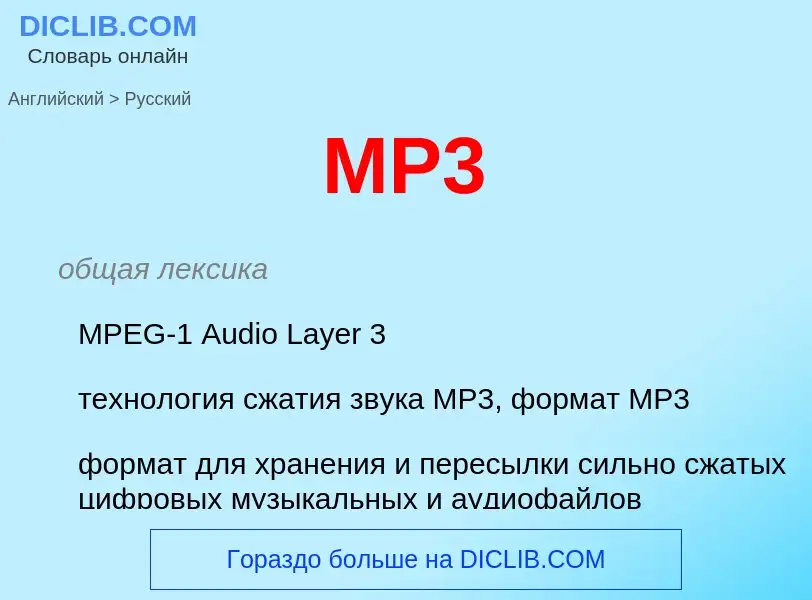Tradução e análise de palavras por inteligência artificial ChatGPT
Nesta página você pode obter uma análise detalhada de uma palavra ou frase, produzida usando a melhor tecnologia de inteligência artificial até o momento:
- como a palavra é usada
- frequência de uso
- é usado com mais frequência na fala oral ou escrita
- opções de tradução de palavras
- exemplos de uso (várias frases com tradução)
- etimologia
MP3 - tradução para Inglês
общая лексика
MPEG-1 Audio Layer 3
технология сжатия звука MP3, формат MP3
формат для хранения и пересылки сильно сжатых цифровых музыкальных и аудиофайлов
Смотрите также
общая лексика
музыкальный файл в формате MPEG 3
[saundri'kɔ:diŋ]
общая лексика
звукозапись
запись звука
Wikipédia
MP3 (formally MPEG-1 Audio Layer III or MPEG-2 Audio Layer III) is a coding format for digital audio developed largely by the Fraunhofer Society in Germany under the lead of Karlheinz Brandenburg, with support from other digital scientists in the United States and elsewhere. Originally defined as the third audio format of the MPEG-1 standard, it was retained and further extended — defining additional bit-rates and support for more audio channels — as the third audio format of the subsequent MPEG-2 standard. A third version, known as MPEG 2.5 — extended to better support lower bit rates — is commonly implemented, but is not a recognized standard.
MP3 (or mp3) as a file format commonly designates files containing an elementary stream of MPEG-1 Audio or MPEG-2 Audio encoded data, without other complexities of the MP3 standard.
With regard to audio compression (the aspect of the standard most apparent to end-users, and for which it is best known), MP3 uses lossy data-compression to encode data using inexact approximations and the partial discarding of data. This allows a large reduction in file sizes when compared to uncompressed audio. The combination of small size and acceptable fidelity led to a boom in the distribution of music over the Internet in the mid- to late-1990s, with MP3 serving as an enabling technology at a time when bandwidth and storage were still at a premium. The MP3 format soon became associated with controversies surrounding copyright infringement, music piracy, and the file ripping/sharing services MP3.com and Napster, among others. With the advent of portable media players, a product category also including smartphones, MP3 support remains near-universal.
MP3 compression works by reducing (or approximating) the accuracy of certain components of sound that are considered (by psychoacoustic analysis) to be beyond the hearing capabilities of most humans. This method is commonly referred to as perceptual coding or as psychoacoustic modeling. The remaining audio information is then recorded in a space-efficient manner, using MDCT and FFT algorithms. Compared to CD-quality digital audio, MP3 compression can commonly achieve a 75 to 95% reduction in size. For example, an MP3 encoded at a constant bitrate of 128 kbit/s would result in a file approximately 9% of the size of the original CD audio. In the early 2000s, compact disc players increasingly adopted support for playback of MP3 files on data CDs.
The Moving Picture Experts Group (MPEG) designed MP3 as part of its MPEG-1, and later MPEG-2, standards. MPEG-1 Audio (MPEG-1 Part 3), which included MPEG-1 Audio Layer I, II and III, was approved as a committee draft for an ISO/IEC standard in 1991, finalised in 1992, and published in 1993 as ISO/IEC 11172-3:1993. An MPEG-2 Audio (MPEG-2 Part 3) extension with lower sample- and bit-rates was published in 1995 as ISO/IEC 13818-3:1995. It requires only minimal modifications to existing MPEG-1 decoders (recognition of the MPEG-2 bit in the header and addition of the new lower sample and bit rates).



![Snow White and the Seven Dwarfs]]'', 1938 Snow White and the Seven Dwarfs]]'', 1938](https://commons.wikimedia.org/wiki/Special:FilePath/Framför en inspelningsapparat står Tatjana Angelini.jpg?width=200)

![RCA-44, a classic [[ribbon microphone]] introduced in 1932. Similar units were widely used for recording and broadcasting in the 1940s and are occasionally still used today. RCA-44, a classic [[ribbon microphone]] introduced in 1932. Similar units were widely used for recording and broadcasting in the 1940s and are occasionally still used today.](https://commons.wikimedia.org/wiki/Special:FilePath/RCA 44 of CBS 20071104.png?width=200)
.jpg?width=200)


